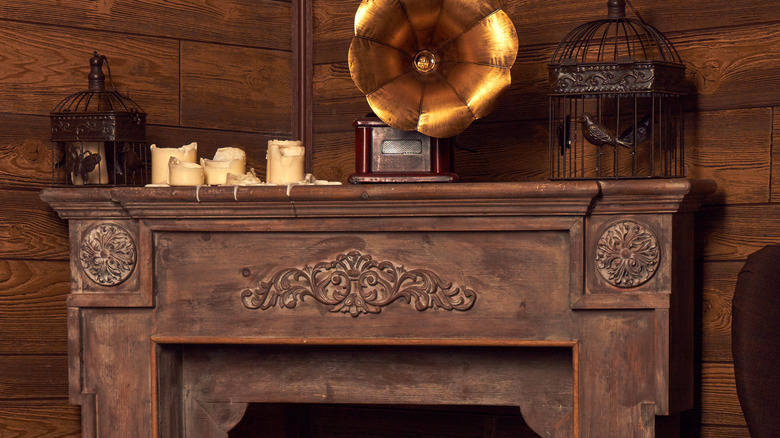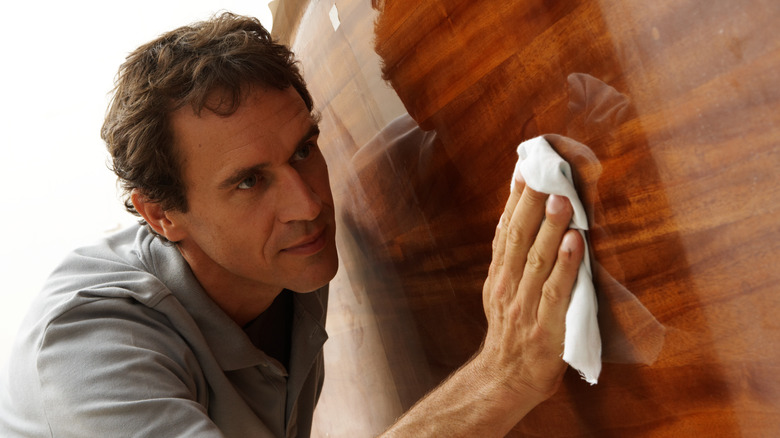How To Clean An Antique Wood Mantel So It Continues To Shine
Nothing says cozy and classic like an antique wood mantel. They come with personality, timelessness, creative styling options, and like all antique furniture, some necessary upkeep. Keeping your mantel clean is important, but because of its material and age, cleaning requires some special care and attention. The key to the best way to clean wood furniture is a small amount of preparation and working slowly and gently.
Before cleaning starts, it's important to determine what kind of wood finish you're working with. To do this, you'll need cotton swabs, a denatured alcohol like a wood spirit, and protective gloves. Denatured alcohol is ethanol with additional ingredients that make it a more powerful cleaner, but it's also toxic, so make sure not to skip the gloves.
With all your materials ready, it's time to swipe a cotton swab dipped in a small amount of the alcohol across an inconspicuous part of your mantel. Then, observe how the wood finish reacts to the alcohol. Does it dissolve? If so, your mantel is finished with shellac, which means it will need to be refinished. Does the wood finish stay undissolved? If so, congrats! You have a type of finish that's safe to proceed with cleaning.
Steps to clean your antique wood mantel
Now it's time to get into the actual cleaning. First, gather your materials. You'll need a soft cloth for cleaning, another cloth for buffing, a small soft-bristled brush, and dish soap. Next, clean off your mantel's top layer of grime by dusting the mantel with your soft cloth. Microfiber works well since it traps dirt and dust rather than moving it around, but make sure to avoid common microfiber mistakes like using the wrong side of the cloth. Don't skip the hard-to-reach spots! Corners and grooves in the wood are where your small soft-bristled brush comes in handy — you can even use a spare toothbrush to do the job.
For the next round of cleaning, prepare your soap by diluting warm water with a few drops of a mild dish soap. Using a soft cloth or sponge, wipe your antique wood mantel in the direction of the wood grain. Your cloth should be damp, not soaked, to avoid warping or damaging the wood. You can also use a cleaning spray specifically meant for antique wood for this step, in which case you'll spray the cleaner directly onto your cloth, and again wipe with the grain.
Then, grab your dry cloth to buff and dry the mantel. Work gently, but make sure to soak up any remaining moisture to prevent water damage. Once your antique wood mantel is dry, you should be able to see its natural shine again.
Should you polish or wax your antique wood mantel?
If natural shine isn't enough for you, there's a bonus step to make your antique wood mantel really glisten: polishing. For materials for this step, you'll need a clean soft cloth and wood polish, but make sure you get one gentle enough for natural or antique wood. Apply the wood polish according to its instructions. Just like the last step, you'll want to follow the grain as you wipe.
Instead of polish, you also have the option to apply wax. The difference between polish and wax is that polish penetrates the wood while wax sits on the surface. This makes waxing a safer option if you're unsure of which way to treat your mantel. To wax your mantel, apply the wax, let it dry according to instructions, then buff it off with a dry cloth. Polish will give you more shine than wax, but both options offer a protective layer that will help your antique wood mantel stay dazzling (and better preserved) for years to come.


